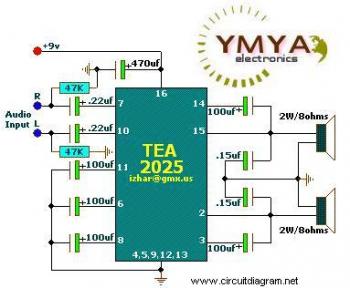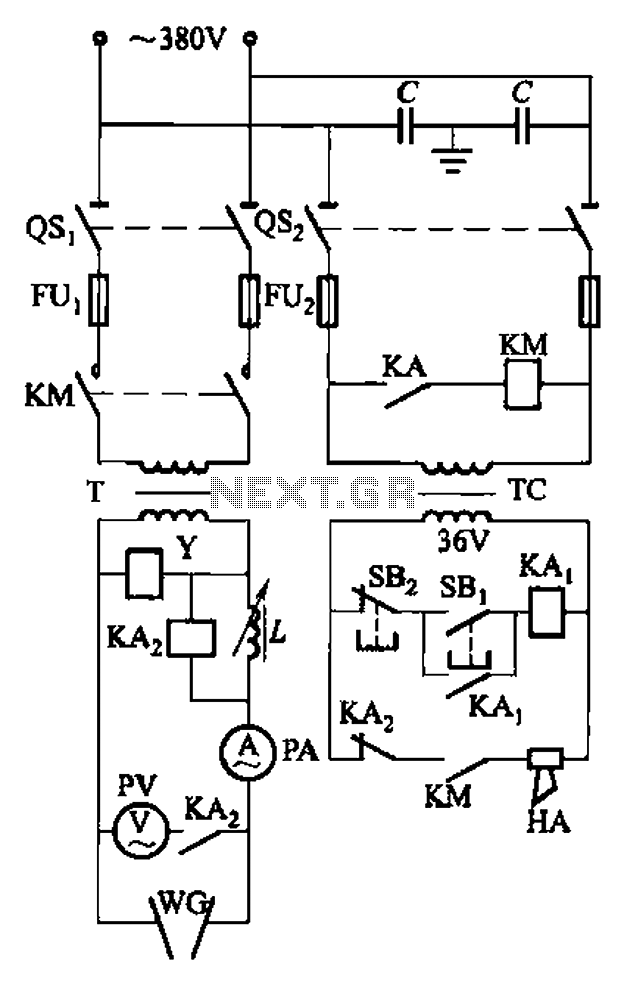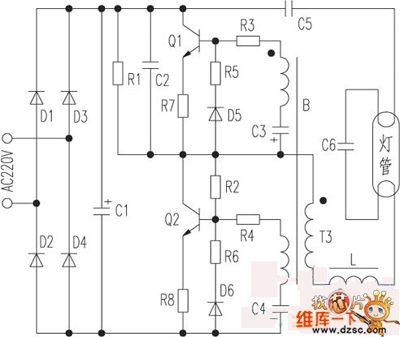
Portable Audio Amplifier circuit diagram

This is a simple portable audio amplifier circuit. The circuit is built around the TEA2025 integrated circuit, which is a monolithic audio amplifier housed in a 16-pin dual in-line package manufactured by UTC. The circuit features an internal thermal protector and is designed for use with portable cassette players and radios. It can also be utilized as an audio amplifier for personal computers.
The portable audio amplifier circuit utilizing the TEA2025 IC is designed to provide a compact and efficient solution for enhancing audio output from various devices. The TEA2025 is capable of delivering a maximum output power of approximately 2.5 watts per channel into an 8-ohm load, making it suitable for driving small speakers or headphones.
The circuit typically includes a power supply section, which can be powered by batteries or an external DC source, ensuring portability. The input stage of the amplifier is configured to accept audio signals from various sources, such as cassette players or computers, allowing for versatility in use.
Key components of the circuit include capacitors for coupling and decoupling, which help to filter out noise and stabilize the power supply. Resistors are used to set gain levels and ensure proper biasing of the amplifier. The internal thermal protector within the TEA2025 IC provides an added layer of safety, preventing damage due to overheating, which is particularly important in portable applications where heat dissipation may be limited.
To construct the circuit, a PCB layout can be designed to accommodate the 16-pin configuration of the TEA2025, along with the necessary passive components. Proper attention should be given to the layout to minimize interference and ensure optimal performance. The amplifier can be encased in a portable housing, allowing for easy transport and use in various environments.
Overall, this portable audio amplifier circuit represents a practical solution for enhancing audio playback in a variety of applications, combining efficiency, portability, and ease of use.This is simple portable audio amplifier circuit. This circuit built based on IC TEA2025 which is a monolithic integrated audio amplifier in a 16-pin plastic dual in line package manufactured by UTC. Circuit has Internal Thermal Protector. It is designed for portable cassette players and radios. You can also use it as your PC Audio Amplifier. 🔗 External reference
The portable audio amplifier circuit utilizing the TEA2025 IC is designed to provide a compact and efficient solution for enhancing audio output from various devices. The TEA2025 is capable of delivering a maximum output power of approximately 2.5 watts per channel into an 8-ohm load, making it suitable for driving small speakers or headphones.
The circuit typically includes a power supply section, which can be powered by batteries or an external DC source, ensuring portability. The input stage of the amplifier is configured to accept audio signals from various sources, such as cassette players or computers, allowing for versatility in use.
Key components of the circuit include capacitors for coupling and decoupling, which help to filter out noise and stabilize the power supply. Resistors are used to set gain levels and ensure proper biasing of the amplifier. The internal thermal protector within the TEA2025 IC provides an added layer of safety, preventing damage due to overheating, which is particularly important in portable applications where heat dissipation may be limited.
To construct the circuit, a PCB layout can be designed to accommodate the 16-pin configuration of the TEA2025, along with the necessary passive components. Proper attention should be given to the layout to minimize interference and ensure optimal performance. The amplifier can be encased in a portable housing, allowing for easy transport and use in various environments.
Overall, this portable audio amplifier circuit represents a practical solution for enhancing audio playback in a variety of applications, combining efficiency, portability, and ease of use.This is simple portable audio amplifier circuit. This circuit built based on IC TEA2025 which is a monolithic integrated audio amplifier in a 16-pin plastic dual in line package manufactured by UTC. Circuit has Internal Thermal Protector. It is designed for portable cassette players and radios. You can also use it as your PC Audio Amplifier. 🔗 External reference





